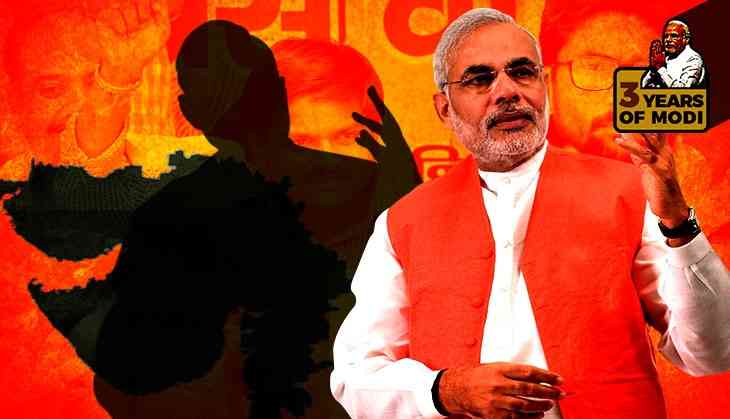Even three years after he left home turf, BJP needs Modi in Gujarat

As Prime Minister Narendra Modi completes three years in office, various ministries and departments at the Centre are coming out with their report cards.
But on the other side of the coin is how his home turf Gujarat has changed in the last three years.
Through his tenure as Chief Minister, Modi has become larger than his parent organisation in Gujarat. The scenario in the state is that the BJP is now identified by Modi, and not vice versa. This is being proven by the fact that the party will go to the Assembly polls with him as the mascot.
Modi is already on his fourth visit to the state this year, trying to galvanise public support in his name for the BJP.
Political tumult
Gujarat is identified as the laboratory of the Sangh Parivar, and a citadel of the BJP, where it claims to be invincible. But the developments since Modi's departure have not been to the satisfaction of either.
Modi had left the state having kept his flock together for almost 14 years. Any sign of disgruntlement or dissidence was quelled immediately.
But his departure to New Delhi changed this. In the last three years, the state has seen a change of guard twice. Though Anandiben Patel was promoted to the CM's post as Modi's successor, observers say that the RSS had to promote her rival Amit Shah to the post of the BJP president at the Centre.
Throughout her tenure, there were rumours of her being replaced by Shah or one of his men. The change did come in the form of Vijay Rupani, who is seen as close to both Modi and Shah. But whether it was Anandi's regime or now Rupani's, the general perception is that the government in Gujarat, including police functioning, is being remote controlled from Delhi.
Rupani had come in as a balancing factor, pipping Nitin Patel to the post. The latter, like Anandiben, is a representative of the powerful Patel lobby in the state.
Larger unrest
Modi's departure has also been marked by two major constituents going up in arms against the government. Anandiben's term was marked by the Patidar agitation for reservation in government jobs and educational institutions, under Hardik Patel.
Till now, the attempts by the BJP to pacify the agitating Patels have not yielded any foolproof results. It remains to be seen how the Patels play it out in the forthcoming Assembly polls.
It was under the BJP regime of Keshubhai Patel that the economically and politically powerful Patel lobby had consolidated almost completely behind the BJP. Despite Modi not being a Patel, the lobby continued its complete support to the BJP, since its interests were not harmed in any way and the community also had no other option in the form of a powerful leader.
But it was Hardik who fired the imagination of the youth in the community and the cracks appeared. The appointment of Nitin Patel as the deputy chief minister was not of much help either. It was just two days ago that Nitin, in a fresh bid to woo the Patidars for the BJP, pointed that successive BJP governments had given more to the Patels than to any other community.
If the Patels played truant for Anandiben, it was the Dalit agitation that shook her successor Rupani's regime. The agitation that had followed the Una episode of four Dalits being flogged not only exposed the 'Gujarat model' of development being marketed by Modi and the BJP at the national level, it also showed the darker side of Gujarat that has often been hid by showcasing cities like Ahmedabad, Vadodara, Surat, Rajkot and the region of Kutch.
To make things worse, both the Patel and the Dalit agitations had their roots in Saurashtra, the region that accounts for nearly one-third of the total Assembly seats and has been dominated by the BJP.
Then came demonetisation, which hit not only the business people but also put the farmers on the path of agitation. There is still a major resentment among the small traders and those who have lost jobs in sectors like diamond industry and textiles.
Other developments
With the minorities already estranged from the BJP and these other communities too airing their intentions of departing its fold, it was time for the repeat of the old tactics of polarisation.
So, in the last few months, Gujarat has seen the Cow Slaughter Act being made more stringent, along with the Prohibition Act. There have been riots at various places, leading to fear among the minorities.
The posturing of Hindutva organisations has added to this atmosphere. Elements like Pravin Togadia of the Vishva Hindu Parishad are once again spewing venom against the minorities, and an atmosphere of 'us versus them' is being created, amid the BJP's call to win more than 150 of the 182 Assembly seats in the forthcoming elections.
Observers point out that government is out on a drive to announce big projects and distribute largesse.
“So now, Modi himself has got down to ensuring support for the party. This is his 12th visit to Gujarat after becoming the Prime Minister and the fourth this year,” says senior political analyst RK Mishra.
Modi had, last month, held a road show in Surat with the same motive. His critics say that he has already started campaigning for the Gujarat polls as if these were some local body elections.
Dangerous sign
Mishra points out that BJP getting identified by Modi's face is a dangerous thing for the party. “It is like Congress never recovering from the collapse of its structure when the slogan 'Indira is India and India is Indira' was coined. Things would be much worse for the BJP, since it is a cadre-based party. This party stood on the pyramid of leaders like AK Patel, Kanshiram Rana, Keshubhai Patel and Makrand Desai in Gujarat. After Modi's arrival, this pyramid has got inverted. It is good until the time the going is good. But when the going gets tough, things will be worse for this party,” he says.
He further highlights how the culture of not raising any voice of dissent developed under Modi's regime in Gujarat. Leaders who raised their voice were politically demolished, to the extent that they had to come crawling back. The case of former Union Minister of State for Heavy Industries, Vallabhbhai Kathiria, and former Gujarat Home minister Gordhan Zadafia are quoted as examples.
Lack of opposition
For the BJP, the biggest advantage continues to be a lack of credible opposition. The lone party in Opposition, the Congress, continues to be in a disarray at the state level. It remains to be seen how much it can succeed in converting the present discontent against the BJP into votes for itself.
In the last three years, Modi has been trying hard to sell his 'Gujarat model', but the very same model has got considerably tarnished on his home turf.
First published: 23 May 2017, 22:10 IST

